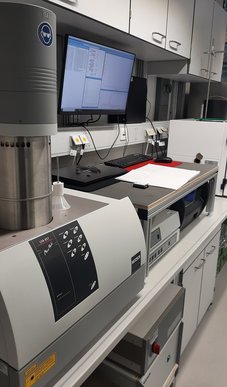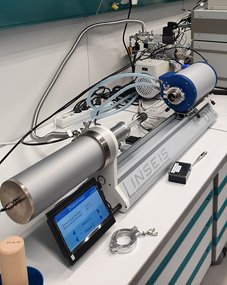The Thermal Petrophysics Laboratory offers a wide range of measurement methods, primarily for determining the thermal properties of rocks and minerals.
In addition, mineralogical and other petrophysical parameters can be determined. The following parameters can be measured:
- Thermal conductivity (TCS, TLS, TPS; LFA) (-150°C to 1,100°C)
- Thermal diffusivity (TCS, TLS, TPS; LFA) (-150°C to 1,100°C)
- Volumetric heat capacity
- Coefficient of thermal expansion (Dil) (RT to 1,000°C)
- Porosity (by immersion weighing)
- Density (by immersion weighing, Dil)
- Permeability (TinyPerm)
- Mineralogy (XRD)
For measurements under combined in-situ pressure and temperature conditions, we are developing an autoclave based on a modified pulse method. Depending on the purpose of the measurement and the applicable sample preparation steps, the most suitable samples are either full or half cores, outcrop samples, or cuttings. To prepare rock samples (sawing, drilling, polishing), we use various in-house facilities. Over the years, we have gained extensive experience in the preparation, measurement, and scientific analysis of thousands of sedimentary, igneous, and metamorphic rocks. Depending on the rock type and application, we can saturate the samples with various pore fluids (air, water, formation fluid, heptane, isooctane, etc.) for measurement.
We offer our expertise through scientific collaborations as well as a service.
Looking for more information or interested in working with us? Contact us by email.
- Fuchs, S., Norden, B., Peksa, R. (2024): Bohrlochgeophysikalische Messungen an den Geothermiebohrungen Gt Khn 1/88 und Gt Khn 2/87 (Karlshagen, MV).
- Fuchs, S., Norden, B., Peksa, R. (2024): GFZ Thermal Petrophysics Lab – Data Report 2024-01: Thermal properties of the shaly Jurassic (Upper Toarcian) formation at the Tournemire underground research lab (Tournemire, France).
- Norden, B., Virchow, L., Fuchs, S., Mitzscherling, J., Gravendyck, J., Zimmer, M., Saadat, A., Section Geomorphology, Sediment Lab (2023): The explorational drilling Gt BTrKoe 1/2021 in Berlin Adlershof, Germany - Field Data and Measurements.
- Fuchs, S., Förster, H.-J., Norden, B., Balling, N., Miele, R., Heckenbach, E. L., Förster, A. (2021): The thermal diffusivity of sedimentary rocks: empirical validation of a physically based α − ϕ relation. - Journal of Geophysical Research: Solid Earth, 126, 3, e2020JB020595.
- Fuchs, S., Förster, H., Braune, K., Förster, A. (2018). Calculation of Thermal Conductivity of Low-Porous, Isotropic Plutonic Rocks of the Crust at Ambient Conditions From Modal Mineralogy and Porosity: A Viable Alternative for Direct Measurement?. - Journal of Geophysical Research 123(10): 8602-8614.
- Fuchs, S., Förster, H.-J., Braune, K., Förster, A. (2018): Calculation of thermal conductivity of low-porous igneous rocks from modal mineralogy.
- Schintgen, T., A. Förster, H.-J. Förster and B. Norden (2015). Surface heat flow and lithosphere thermal structure of the Rhenohercynian Zone in the greater Luxembourg region. Geothermics 56(0): 93-109.
- Ray, L., H.-J. Förster, A. Förster, S. Fuchs, R. Naumann and O. Appelt (2015). Tracking the thermal properties of the lower continental crust: Measured versus calculated thermal conductivity of high-grade metamorphic rocks (Southern Granulite Province, India). Geothermics 55(0): 138-149.
- Schütz, F., H.-J. Förster and A. Förster (2014). Thermal conditions of the northern Sinai Microplate inferred from new surface heat-flow values and continuous borehole temperature logging in central and southern Israel. Journal of Geodynamics 76: 8-24.
- Fuchs, S., F. Schütz, H.-J. Förster and A. Förster (2013). Evaluation of common mixing models for calculating bulk thermal conductivity of sedimentary rocks: correction charts and new conversion equations. Geothermics 47(-): 40–52.
- Schütz, F., B. Norden, A. Förster and D. Group (2012). Thermal properties of sediments in southern Israel: a comprehensive data set for heat flow and geothermal energy studies. Basin Research 24(3): 357-376.
- Fuchs, S. and A. Förster (2010). Rock thermal conductivity of Mesozoic geothermal aquifers in the Northeast German Basin. Chemie der Erde-Geochemistry 70(S 3).
Measurements were performed in the frame of scientific cooperations or projects for the following instituts and companies (selection):
- Alberta Geological Survey (Canada)
- University of Bologna (Italy)
- Aarhus University (Dänemark)
- Technical University Darmstadt (Germany)
- Dublin Institute for Advanced Studies (Ireland)
- University of Leads (UK)
- University Wrocław (Poland)
- EAVOR (Canada, Germany)
- Geomecon (Germany)
- BGE (Germany)
Thermal Conductivity Scanner (TCS)

Measurement Principle: The Thermal Conductivity Scanner (TCS) employs the optical scanning method, where a concentrated mobile heat source scans the sample's surface. Infrared sensors measure temperature variations along the scanning line, enabling the calculation of thermal conductivity ot thermal diffusivity profiles within an error of 3-5%.
Applications: Optical scanning is utilized for rapid measurements of thermal conductivity and diffusivity in various rock types and geo materials under ambient laboratory conditions. It is particularly effective for analyzing large-scale samples with variable shapes, such as full cores, half cores, or outcrop samples.
Operational Conditions: Ambient laboratory pressure and temperature conditions; samples in dry or fluid-saturated conditions. Samples preferably have a plane surface; core mantles can be measured in principle as well. Samples can be hard and soft rocks.
Advantages: The TCS provides continuous thermal property profiles with high spatial resolution, facilitating detailed analysis of thermal conductivity variations across heterogeneous samples.
Hot Disk | Transient Plane Source (TPS 1500)

Measurement Principle: The Hot Disk method utilizes a sensor consisting of a double spiral nickel foil, which acts as both a heat source and a thermometer. Placed between two sample pieces, the sensor applies a current, and the resulting temperature increase is monitored to determine thermal conductivity, thermal diffusivity, and specific heat capacity.
Applications: TPS 1500 is employed for comprehensive thermal analysis of rocks and geomaterials, capable of operating under both ambient and elevated temperature conditions. It is suitable for small to medium-sized samples requiring precise thermal property measurements.
Operational Conditions: Temperature RT to 600°C, Samples with plane surface or splitted samples, Sensor size and operational modus depends on sample dimensions, Saturation states of samples can be dry or water-saturated
Advantages: The TPS 1500 provides accurate measurements of multiple thermal properties and can simulate in-situ reservoir temperatures, making it valuable for geothermal research and other high-temperature applications.
Needle Probe | Transient Line Source (Thermtest MP2)

Measurement Principle: The needle probe method, based on the transient line-source technique, involves inserting a probe containing a heating element and temperature sensors into the sample. By monitoring the temperature response over time, the thermal conductivity is determined. This method is advantageous for its simplicity and suitability for in-situ measurements.
Applications: This technique is suitable for measuring thermal conductivity or volumetric heat capacity (depending on the selected needle) in both dry and saturated soil and loose rocks, accommodating various fluids such as air, tap water, distilled water, and heptane. It is effective for samples where drilling a hole for probe insertion is feasible.
Operational Conditions: Temperature range is between RT and 50°C; the sample forms can be core cylinders, cubes (hard and soft rocks), or soil and loose sediment; the saturation states can be various fluid-saturateions
Advantages: The needle probe is easy, mobile, and works in soft rocks and sediments, and offers a straightforward method, especially in field settings.
Laser-Flash Analysis (Netzsch LFA 457 Microflash)

Measurement Principle: Laser-Flash Analysis involves subjecting the sample's surface to a short laser pulse and measuring the temperature rise on the opposite surface. The thermal diffusivity is calculated based on the time taken for the temperature change to occur. The volumetric heat capacity is derived using reference standards, allowing for the computation of thermal conductivity. This method is highly regarded for its precision in determining thermal properties over a wide temperature range.
Applications: The LFA 457 is used to measure thermal diffusivity and volumetric heat capacity of geomaterials under a wide range of temperatures, making it suitable for studying temperature-dependent thermal behaviors.
Operational Conditions: Equipped with two ovens, we can handle a temperature range between -125°C and +1,100°C. Prepared samples are small discs with diameters between 7 and 12.6 mm (1/2" in) and thicknesses between 2 and 4 mm. The materials are consolidated rocks and geomaterials. Samples are measured under dry conditions.
Dilatometer (Linseis DIL L75 HD)

Measurement Principle: The Dilatometer measures dimensional changes in a sample as a function of temperature. By precisely recording expansion or contraction, it determines properties such as thermal expansion coefficient and density variations. This technique is crucial for understanding material behavior under thermal stress.
Applications: The DIL L75 HD is utilized to assess the thermal expansion behavior and ths the temperature-dependent density change of rocks and geomaterials, providing insights into structural stability and integrity under thermal stress.
Operational Conditions: temperature range between RT to 1,000°C, sample forms are cylinders of varying dimension of solid specimens
Mobiles Permeameter (TinyPerm 3)

Measurement Principle:
The TinyPerm 3 (New England Research, Inc.) is a handheld air permeameter designed for rapid estimations of rock permeability. It operates on the transient-flow method, where a known volume of air is injected into the sample, and the pressure decay is monitored to calculate permeability. This technique allows for quick assessments on dry rocks without the need for extensive sample preparation.
Applications:
The TinyPerm 3 is ideal for field and laboratory measurements of matrix permeability in outcrops, cores, and plug samples. Its portability and ease of use make it suitable for geological surveys, reservoir characterization, and studies requiring high spatial resolution of permeability variations. It helps to pre-select rock samples for further in-depth permeability measurements.
Operational Conditions: Measurement range is approximately 0.01 mD to 10 Darcy; works on dry samples from outcrops, core plugs, and rock surfaces.
X-ray Diffractometer (Bruker D6 PHASER)

Measurement Principle:
The D6 PHASER is a benchtop X-ray diffractometer that performs phase identification and quantification through powder diffraction techniques. It utilizes a theta/theta goniometer and advanced detectors to collect diffraction patterns, which are then analyzed to determine crystallographic information. The instrument supports various geometries, including reflection and transmission modes, enhancing its analytical capabilities.
Applications:
We employ the D6 PHASER for analyzing crystalline structures, identifying phases, and quantifying the mineral abundances and properties.
Operational Conditions: x-ray Source Power: Up to 1.2 kW; sample Types: powders of geomaterials; Measurement Modes: Reflection, transmission, grazing incidence, and non-ambient conditions